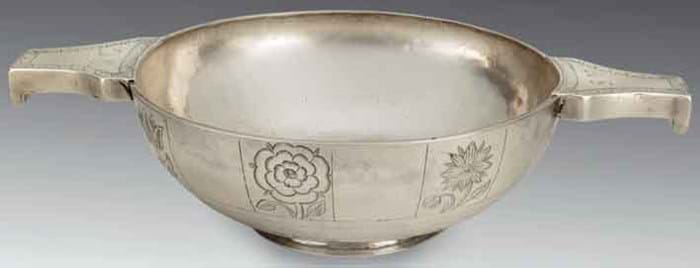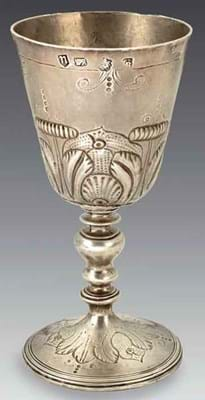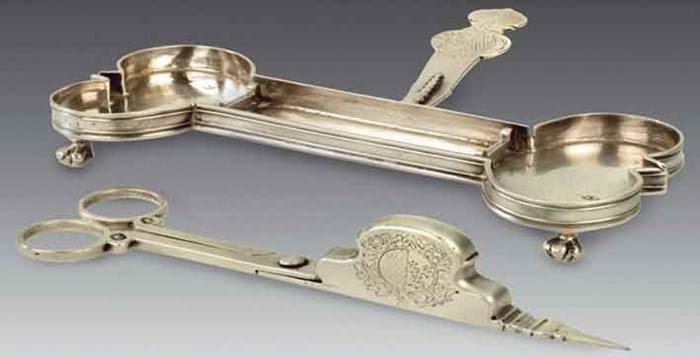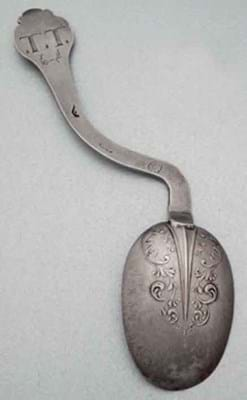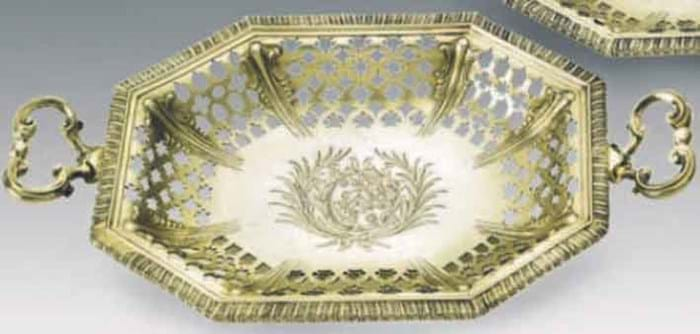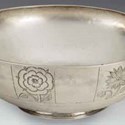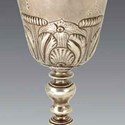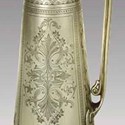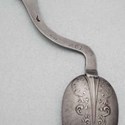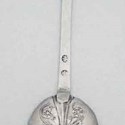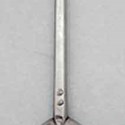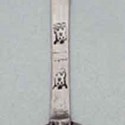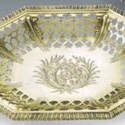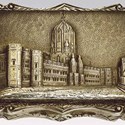Jane Penrice How, who died on June 25, 2004, at the age of 89, was a legendary figure in the silver world - remembered as both an expert on early English, Scottish and Irish silver and as an eccentric who did not suffer fools gladly.
Known as "Ben" to her friends, and simply as "Mrs How' to acquaintances, her enthusiasms were wide-ranging: wine, opera, fishing, shooting, edged weapons, beekeeping, dogs, cricket and motorcars.
A diminutive figure in her tweed twin-sets, she was often accompanied around London's elegant St James's district by her huge Old English mastiffs - a breed she helped save from extinction - or seen peeping over the dashboard of the latest Bentley turbo as she took on all-comers at traffic lights.
But Mrs How established her fearsome reputation as a leading expert on early silver and English spoons in particular. A long-standing member of the Antique Plate Committee at Goldsmiths Hall, where her forthright opinions were aired with some regularity, she met her husband, Commander George Evelyn Paget How, when cataloguing the Ellis spoon collection for Sotheby's in 1935 and, together, they built up a formidable dealership, How of Edinburgh, which had moved to the heart of the West End before the War.
A whole generation of silver dealers, Tom Lumley, Hugh Jessop, John Bourdon-Smith and Brand Inglis, all worked for How at some time in their careers: and their memories of sometimes crusty encounters with unfavoured customers or competitors are now part of trade folklore. After four years' work and several false starts,Woolley & Wallis conducted the How of Edinburgh sale in a single-owner catalogue on October 30 (preceding the regular autumn sale of silver and jewellery from October 31- November 1).
The essence of the assemblage was the former stock of the London dealership but - as is so often the case these days - this did not appear to dilute its appeal. Here was a chance to purchase a little bit of silver dealing history.
The sale was viewed for a full three weeks (including a wine and sandwiches evening for the Silver Society) and attracted the sort of numbers traditionally reserved for a house contents sale.

Above: Charles II tumbler cup, clearly struck for WF (conjoined), London 1683, sold to a dealer bidding for a client for £21,000 at Woolley and Wallis.
Interested parties ranged from a Who's Who of the spoon market to the London trade just back from New York, drawn to Salisbury by some exceptional pieces of stock offered at well below prices which How would have asked, and the many private buyers who had been touched by the How of Edinburgh story some time in its 60-plus-year history.The latter were often happy to take home some of the less-than-spectacular objects as souvenirs. When auctioneer Tim Woolley (one of the few permitted to call Mrs How "Ben") left the rostrum after a full five hours of selling, not a single lot had failed in a packed room. A projected take in excess of £300,000 had become £550,000.
A large holding of cutlery was sold in around 330 lots - a hark back to those distant days of discovery when material was plentiful but the map of silver in the British Isles was only just being charted.
The Benson Collection of spoons - Mrs Howe's personal collection including an extraordinary late medieval spoon with a woodwose (hairy wildman of the woods) terminal - is now on view at the Ashmolean. But here, alongside early forks and sets of early 18th century pistol-handled knives (all wrapped in brown paper and all razor sharp), were trefid- and seal-top spoons carrying a plethora of provincial assays: Gloucester, Wells, Taunton, Bristol, Lewes, Dartmouth, Norwich, Frome, Sherborne, Crewkerne, Cirencester, Salisbury, Plymouth, Dorchester,York, Hull and Exeter.
Each was photographed front and back in a catalogue that will serve as a worthy record. They ranged from the very average to an extraordinary Charles II laceback spoon with an S-shaped handle, thought to have been made by Robert King in 1679 for an arthritic user (£1200), to a flawed, but super-rare, spoon of similar date struck with a tower with three turrets and three flags - marks attributed to Kilkenny (£4200).
Spoons from York, Bristol and Norwich provided the leading sums.The Norwich spoon was a Charles I seal-top with a small gilt seal, pricked SH over AE on a slender stem with a large bowl. It was fully marked for James Grundy (I) or (II), Norwich 1634. It sold at £5400 (estimate £1200-1800).
There were three Bristol spoons in the sale (a maidenhead c.1600 in excavated condition was acquired by specialist Alex Butcher from a dealer after the sale as a souvenir), but the best example was a fine Elizabeth I apostle with a large gilt figure of St Paul with a pierced spoked nimbus and carrying a sword.
In addition to scratched initials Dover NH, was a maker's mark T Gover a fleur-de-lys, possibly for Thomas Goodyear, c.1590. It sold at more than three times the top estimate at £7800.
Two York apostles more than doubled hopes: a James I St Judeby Robert Casson, 1612 (£6000) and an early Charles I St James the Greaterby Thomas Harrington, 1626 (£6600).
There were many interesting hollowwares, mainly from the second half of the 17th and the early years of the 18th century.
Here, again, the estimates were generally modest: evidence that once W&W had seen off the competition for this consignment they were under no pressure to make big promises to their vendor, Jane How's grandson. Some lots were quite deliberately pitched very low to attract interest.
These included a pair of George III octagonal silver-gilt sweetmeat dishes by John Parker and Edward Wakelin, London 1766. With gadrooned borders, cast scroll handles, finely pierced sides and a large armorial engraved to the centre, these 9in (23cm) wide, 20oz dishes were never going to be had for the £700-900 printed estimate and, indeed, took around ten times the money at £7600.
But a packed room also guaranteed some strong prices.
Chief among these were the sums achieved for a Charles II tumbler cup (estimate £2500-3000) and a Charles I wine goblet (estimate £3000-4000). The 6oz tumbler cup, clearly struck for WF(conjoined), London 1683, was deemed an exceptional survival. A little earlier than most of this form, it was engraved with a contemporary coat of arms for Garnish, County Suffolk, or Mitchell, County Sussex, within plumed mantling and had the colour and 'skin' collectors look for. At £21,000, it sold to Jermyn Street dealer Alistair Dickenson who, bidding on the telephone, was among the biggest buyers in this second section of the sale. On this occasion, he toldATG, he was buying for a client.
The wine goblet, with embossed and chased decoration, was also a good example of a recognisable type with marks forCB(in monogram), London, 1630. Appealing, perhaps, for its relatively small size - it was 5in (13cm) high - it went to the London trade at £20,000.
A William III snuffer stand was of a rare waisted or 'bone' form. It was marked for John Bodington, London 1697 and sold together with a pair of snuffers by Joseph Bird (London, 1700) which shared the same period coat of arms. These are among the scarcest of all the snuffer forms and Alistair Dickenson bought them for a client at £15,000 - some ten times the estimate. A Queen Anne snuffer stand of the more familiar octagonal form by Edmund Pearce, London 1713, together with a pair of early George I snuffers by Edward Peacock, London 1714 - both engraved with the contemporary arms of Sydney of Cowpens Hall, County Essex - made their price at £13,000.
These were then followed by a real rarity: a George I miniature octagonal snuffer stand and snuffers, maker David Clayton, London 1715, standing just 4in (10cm) high. Alistair Dickenson bought them at £4400 (estimate £500-700). Sold at £3800 (estimate £600-800) was a rare 4.75oz snuffer stand of teardrop form raised on three button feet, with a trefid and ring handle. It had the scratched initials AAB and the maker's mark PA with crown above and five petalled flowers below.
The form is known in Channel Islands silver and indeed the marks were identified by Alistair Dickenson, who bought them for stock, as those of Huguenot smith Pierre Amiraux of Jersey, c.1700. More familiar to the trade was a suite of three Charles II casters, each with corrugated cylindrical bodies with pierced, domed bases engraved with stiff leaves.
The larger 7in (18cm), the smaller two 6in (15cm) apiece, they carried the maker's markWB[mullet below], London 1682/1683 and were engraved with the contemporary initialsAP. They sold at £40,000 (estimate £18,000-25,000) but when bought by Mrs How at a London sale 15 years ago they cost much the same amount.
Sold at £29,000 (estimate £20,000-30,000) was a rare Queen Anne Scottish quaich, a substantial 121/8in (30.7cm) long, engraved to the bowl with alternating plain and floral panels and marked for William Clerk, Glasgow 1707.
For a piece of this size, decoration and history it was surely not expensive. Bury Street, St James's dealers N. & I. Franklin were the buyers. Combined with the mixed-owner sale of silver and jewellery more than £1.1m was taken by W & W over three days. They believe it is the first silver and jewellery sale outside London to break the seven figure barrier.They might well be right.
The mixed owner silver sale and the jewellery sale on October 31-November 1 which immediately followed the How silver at Woolley & Wallisadded a further £615,000 to a profitable three days at the Salisbury Salerooms.
In the knowledge that the How sale on October 30 would be attracting all the major spoon buyers, a vendor chose to include two rarities in the next day's event. One was a medieval diamond point spoon, struck with the leopard's head mark in the bowl, c.1400 (estimate £400-600).The other was a Mary Tudor slip-top spoon with the maker's mark for William Cawdell, London 1555 (estimate £3000-4000). Both had been retrieved from Switzerland to ensure they would make the catalogue at the eleventh hour.
A medieval diamond point with a large tear to the bowl had brought £1600 at the How sale the previous day so it was no great surprise when this example in better condition, a fraction over 6in (15cm) long, took £3400.
The spoon from the brief reign of Mary I (just five years between 1553 and 1558) had a reassuring provenance: it had been bought from Spink & Son Ltd and included an insurance document from the London dealers dated 1976 that valued the 53/4in
(14.7cm) long spoon at £650. Here it sold at £9200.
An early Charles II porringer and cover embossed with trailing flowers and applied with cast caryatid scroll handles brought more than a large Commonwealth example in the Howe sale which had sold at £13,000 - a price the buyer, Alistair Dickenson considered the bargain of the sale.The slightly later example carrying the maker's markICabove a mullet, for London 1661 and including a pair of armorials, weighed 20.5oz and trebled expectations to bring £16,000.
A rare Victorian castletop vinaigrette by Nathaniel Mills (Birmingham 1851) from the same vendor made an exceptional price. The key, as always, was an unusual subject: that of Christchurch, Oxford featuring Tom Tower, in relief. Just 15/8in (4cm) long, it sold to the trade at £6200 (estimate £800-1000).
More predictable was the cover lot and top lot of the sale - a 91/2in (24.2cm) high, Regency silver-gilt presentation cup in the form of a Warwick vase wine cooler by Paul Storr, London 1814 on a copper-gilt plinth stamped for Storr and Mortimer.
It was engraved with a coat of arms and inscribed: Presented by the Officersof the 7th (Queens OWN) Hussars toCol. Edward Kerrison in token of theRespect excited by his Conduct At theBattle of Orthes 27th February 1814and as a mark of the Regard & Esteem they feel towards him August 1814.
It sold to the London trade at £44,000 (estimate £12,000-15,000.
One vendor from a neighbouring county, whose late husband had been a collector of some discernment,consigned some of the most eagerly contested pieces, including an impressive 13in (33cm) high, 35oz wine ewer. Decorated with formal foliate and palmette engraving and two Egyptian masks to the handle, it was marked for H.Steiner, Adelaide, South Australia, c.1880.
Similar vessels (including the Adelaide Hunt Club Cup also by Henry Steiner) are illustrated in the relevant literature and there was lots of interest from Australian buyers well above the £1500-2000 estimate. This example will go Down Under at £7800.

